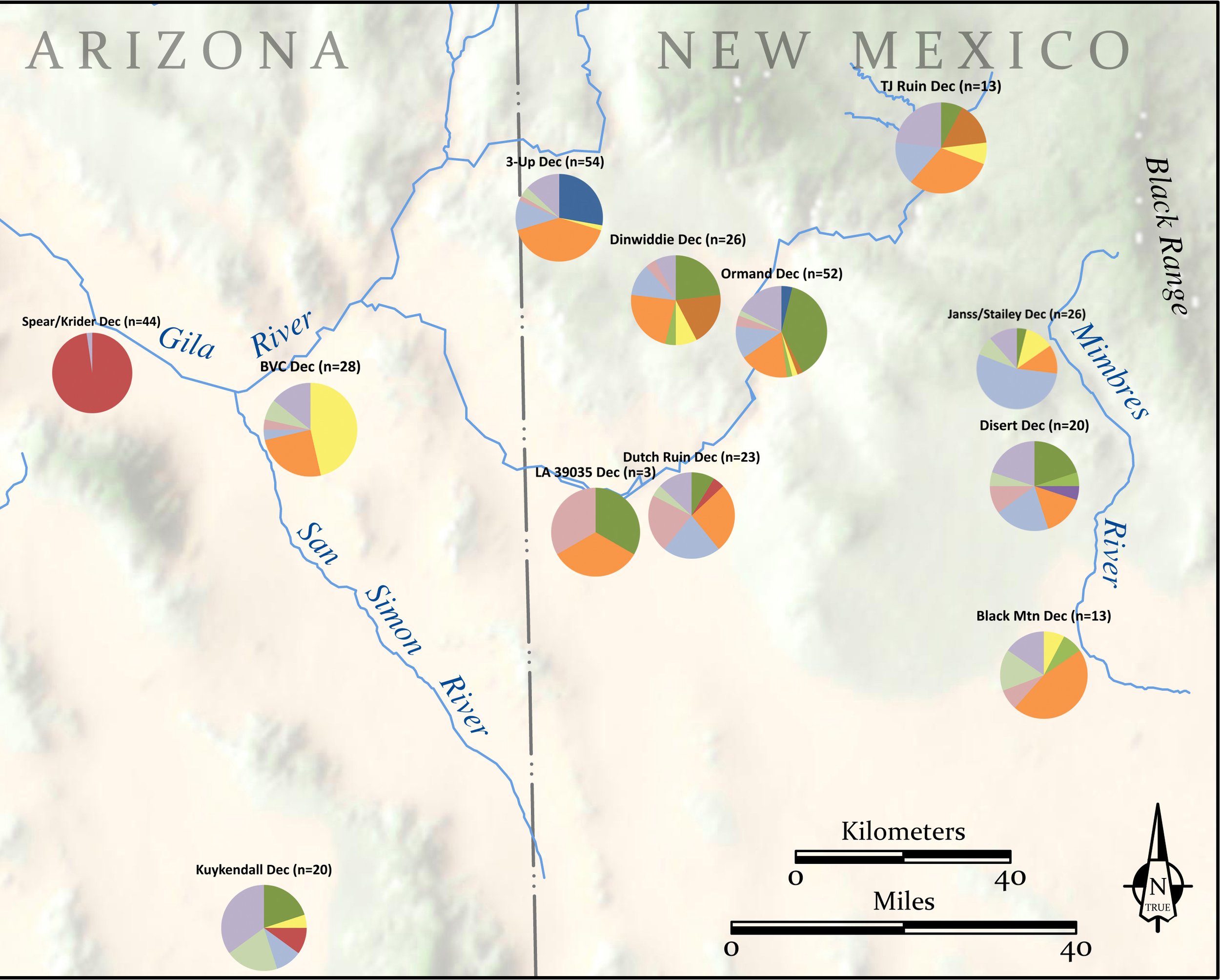Projects in ceramic petrography & other techniques and materials
Map showing pottery acquistion patterns
Salado Polychrome and Social Networks
This research project combined petrographic analysis and elemental (NAA) data to investigate the production and consumption of Salado Polychrome pottery (aka Roosevelt Red Ware). The results indicated the vessels were manufactured at many sites in the southern US Southwest and then exchanged to other communities. This signifies the connection of these groups that had settled in the area in the 13th and 14th centuries AD.
Click here to go to the publication in Journal of Archaeological Science
This project was a collaboration with Archaeology Southwest, a non-profit research group. Conducted through Desert Archaeology, Inc.
Hohokam buff ware sherd
Buff Ware Technology and Communities of Practice
This research project utilized ceramic petrography to investigate the technology of making Phoenix Basin Hohokam Buff Ware. The results revealed that prior to AD 850 crushed schist and sand were employed as temper, but after that period most buff ware was made with schist-rich sand. The primary communities making the vessels were located near the Santan Mountains along the middle Gila River, with distribution to broad areas including Tucson.
Click here to go to the publication in American Antiquity
This work was made possible through the generosity of the Gila River Indian Community . Conducted through Desert Archaeology, Inc.
Arroyo sampled for sand
Pottery Making and Mobility
This research project comprised petrographic analysis of pottery and sand samples from a number of sites in northeastern Colorado. The results showed that Early Ceramic (AD 150-1150) and Late Ceramic (AD 1540-1860) pottery was primarily made in the mountains to the west of the sites using granitic raw materials. This indicates pottery was made during seasonal rounds to exploit mountain resources.
Click here to go to the publication in Plains Anthropologist
To learn more, go to the Center for Mountain and Plains Archaeology at CSU. Conducted through Desert Archaeology, Inc.
Thin section image of Rio Grande Glaze Ware
Glazing and Technological Transfer of Knowledge
This research project focused on two very different pottery traditions, Rio Grande Glaze Ware (14th to 18th centuries CE) from Paragas Pueblo, New Mexico and Medieval (9th to 15th centuries CE) glazed ceramics from Aswan, Egypt. The results highlighted that the knowledge to create a successful glaze paint in New Mexico may have varied by production area, whereas in Egypt the technology was easily transferred and adapted effectively to local raw materials.
Click here to go to the publication in Journal of Archaeological Science: Reports
Funding provided by the National Science Foundation Archaeology Program. Conducted in part through Desert Archaeology, Inc.
Scanning electron microscope image of clay bead
Social Significance of Tiny Clay and Stone Beads
This research project investigated the characteristic features of small stone and clay beads with scanning electron microscopy and chemistry. The results were utilized to assess the presence of these beads in burials from several sites in the Tucson area. The use of clay beads, that were quicker to fashion, appeared to complement stone beads in order to fulfill a mortuary tradition, rather than to deceive viewers about the wealth or status of the deceased.
Click here to go to the publication in American Antiquity
This research was kindly facilitated by the Tohono O’odham Nation. Conducted through Desert Archaeology, Inc.
Fragment of examined specular hematite
A Sparkling Moment
This research project used laser ablation inductively coupled plasma mass spectrometry to acquire elemental data on specular hematite rock samples and the specular hematite paint on Broadline Purple-on-red pottery. The results suggested this tradition was centered around potting communities on the east side of the Tucson Mountains, but was not maintained past the Tortolita Phase (AD 500-700).
Click here to go to the publication in Kiva
Saguaro National Park generously allowed us to sample rocks for this study. Funded by the Arizona Archaeological and Historical Society.
Map of important sites in Early Bronze Age Egypt and the Levant
Early Bronze Age Trade Between Egypt and the Levant
This research project focused on the petrographic analysis of Early Bronze Age pottery vessels in Egypt. The results from multiple projects has shown that Late Predynastic (approx. 3000 BC) trade comprised jars from various producers mostly in the southern Levant. By the 2nd Dynasty (approx. 2700 BC) the focus had begun to move towards the northern Levant, and by the 4th Dynasty (approx. 2500 BC) jars contained specific commodities from production locations in Lebanon.
Click to go to the publications in Agypten und Levante, BASOR, Levant, and Journal of Archaeological Science: Reports. For a video describing the project, go here
This work is supported by the Australian Research Council through Dr. Karin Sowada
Thin section image of unique paste and red slip
Predynastic to Early Dynastic Egyptian Pottery Production
This research project used ceramic petrography to examine over 100 Predynastic to Early Dynastic sherds from several sites in Egypt. The combined results indicated that a certain paste recipe of Nile clay and limestone was typically used for platters. A second unique paste with shale and microfossils in a Nile clay appears to have been used for several hundred years for different vessel forms. Although defining a provenance for Nile clay fabrics is challenging, the characteristics of this paste could suggest production in the Qena area with wide distribution.
The article is in this recently published book, Egypt at its Origins 6.
This project is based at the Institut fur Agyptologie, Vienna with Dr. Christiana Kohler
Making thin sections on site
Commerce in the Age of Ramesses the Great
This research project involved the petrographic analysis of Late Bronze Age transport jars (aka amphorae) brought to the capital of Ramesses the Great (Ramesses II) at Qantir, in the eastern Nile Delta. The goal was to look at the full range of ceramic fabrics (fired clay and inclusions) to determine the extent of commodity acquisition. The results indicated contacts with Syria, Lebanon, and northern Israel/Palestine likely acquiring olive oil, resin, and other goods. Jars even came from Cyprus at this time!
Click to go to the publication in the Journal of Ancient Egyptian Interconnections.
Collaborators are: Dr. Henning Franzmeier, Qantir Project, and the Museum in Hildesheim
Links
Complete list of project publications for US Southwest research
Complete list of project publications for Egypt and Near Eastern research









